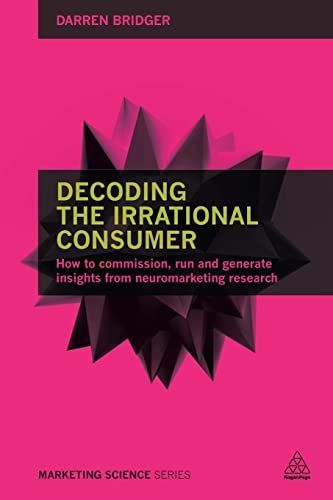
Decoding the irrational consumer how to commission, run and generate insights from neuromarketing research
"New developments in the behavioral sciences have revealed that most people do not accurately self-report their motivations. It is now understood that decision making is driven by emotions and the subconscious, rather than by purely rational calculations. Asking direct questions, as the global marketing and advertising research industry has previously depended on, is no longer enough. Instead, the industry requires a new generation of research tools, such as: behavioral economics, eye-tracking, implicit response measures, and facial coding to find the truth behind what consumers are saying. Decoding the Irrational Consumer provides marketers and researchers with an overview of each of these new research tools and techniques, their individual strengths and weaknesses, and how they can be used to generate consumer insights. Chapter topics cover: key principles and applications, facial coding, heuristics, behavioral experiments, biometric data, prediction markets, creating smarter surveys, and how to combine techniques. An accompanying website will include interviews with industry leaders, example projects, and an annotated bibliography"--
"Marketers increasingly understand that consumer decisions are often irrational, emotional and subconscious. A new generation of research tools, including behavioral economics, eye-tracking, implicit response measures, and facial coding can measure and illuminate these irrational drives. However, whilst there are many books on this subject, none cover all these techniques and the key theories in a way that helps marketers become neuroliterate. Decoding the Irrational Consumer will equip marketers and researchers with an understanding of each neuromarketing tool, its relative strengths and weaknesses, and how to use it to generate consumer insights. Decoding the Irrational Consumer demonstrates how to interpret data and turn it into actionable insights. It explains the pros and cons of each data-source, and when to use them. Finally, it explains when and how data from different sources can be combined. By reading this book, practitioners will have all the key conceptual and theoretical tools to take control of understanding subconscious responses. From briefing the data-processing people, to conferring with neuroscientists and technicians, they will be in the best position to glean practical insights from the data. About the series: The Marketing Science series makes difficult topics accessible to marketing students and practitioners by grounding them in business reality. Each book is written by an expert in the field and includes case studies and illustrations enabling marketers to gain confidence in applying the tools and techniques and in commissioning external research"--